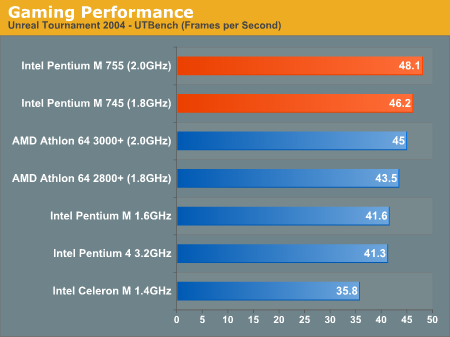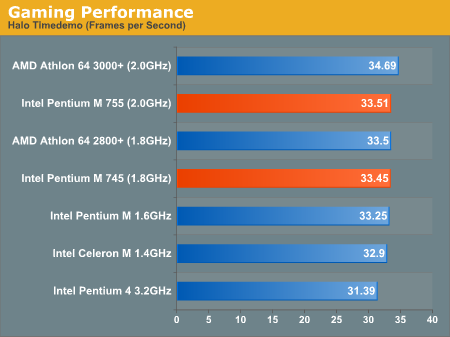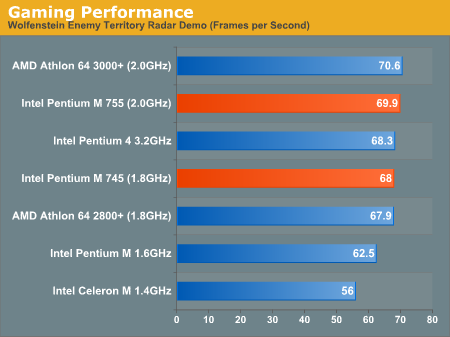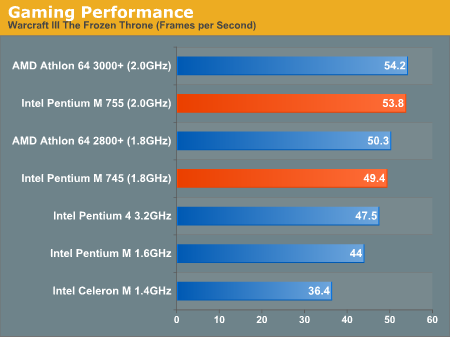Intel's 90nm Pentium M 755: Dothan Investigated
by Anand Lal Shimpi on July 21, 2004 12:05 AM EST- Posted in
- CPUs
Gaming Performance
Mobile gaming is still nowhere near as popular as desktop gaming, but thanks to the efforts of ATI and NVIDIA, it is finally possible.
Under UT2004, the Pentium M manages to outperform the rest of the chips, delivering the highest frame rates. But, keep in mind that even at the low 800x600 resolution we were testing at, the game was still mostly GPU limited by the mobility Radeon 9600.

The performance under Halo, even at 800x600, is mostly GPU limited and thus we see the Athlon 64 3000+ at the top with most of the other contenders.

Under Final Fantasy, the Pentium M takes a backseat to only the Athlon 64. Clock for clock, the Athlon 64 does come out ahead by a negligible 4%.

Here, we have yet another close call, thanks to GPU limitations. Really, only the Pentium M 1.6 and Celeron M 1.4 perform poorly here.

Under Warcraft III, thanks to Blizzard's excellent work at reducing GPU requirements while still making a beautiful game, we finally see some differences between the chips. The Athlon 64 3000+ and Pentium M 755 once again battle it out at the top; and even the Pentium M 745 doesn't mind giving the Pentium 4 3.2 a run for its money.
It would be nice to see what the Pentium M could really do without being held back by a mobile GPU. Unfortunately, there are no decent Pentium M motherboards with an AGP slot that were readily available at the time of this review. Needless to say, the Pentium M can hang with the best of them when it comes to mobile gaming.










28 Comments
View All Comments
nserra - Wednesday, July 21, 2004 - link
#3 I agree. Banias is a better chip. It would be nice to see Banias at 0.09 with 1MB cache, would be smaller, cheaper and a lot more chips per waffer, but Intel isn't interested in these yet, at least maybe a Celeron line when Banias phased out.Isn't Ati 9100 chipset compatible with Banias and P4 compatible? A bios change or something more wouldn’t do the trick?
Matthew Daws - Wednesday, July 21, 2004 - link
Interesting read. Some comments though: the Dothan has a HUGE L2 cache, which people, in a thread over at Ace's, suggest gives it a large edge in many applications (there were complaints that it excels in SpecInt simply because of this, and with very large datasets, performance rapidly tails off). Nothing wrong with that, but it might explain why the Dothan has issues with media-encoding and the like, where the volume of data is so large that the size of the L2 cache becomes less important.Also, the test was a little bit of comparing apples to oranges. I see why this was done: to try and give a laptop-like playing field. But Dothan is almost certainly highly optimised to run with, say, single channel, slow RAM. By forcing this on Athlon64 and Pentium 4 desktops, which are optimised for fatter memory channels, you are slightly crippling performance. As such, it's probably a fair test for laptop performance, but probably doesn't indicate how a Dothan-like desktop chip would hold up. This might explain how well it holds its own against the Athlon64 and beats the P4 in many tests.
Anyhow, good to see a great test of Dothan! Cheers, --Matt
xsilver - Wednesday, July 21, 2004 - link
Just a question... I thought the new sucessor to the prescott was going to be the derivative of the dothan -- eg merging back the mobile and desktop solutions? I'm wrong right? So what exactly are they going to replace prescott with?morcegovermelho - Wednesday, July 21, 2004 - link
Where are the Athlon 64 3000+ scores in Sysmark 2004? (page 8)DigitalDivine - Wednesday, July 21, 2004 - link
interesting to see that we are going back to the old days when intel and amd matches each other clock for clock. a 1.8ghz centrino about the same as a 1.8ghz athlon64.still another note that the p4 is still king in media encoding.
overall a nice review.
adntaylor - Wednesday, July 21, 2004 - link
Excellent chip. However, it's bloody expensive. At $637 it is exactly the same price as a 3.6GHz Prescott 560 or right between Athlon 64 3500+ and 3700+, so it's not a good choice for the desktop.Also Anand's comment "...it's faster and uses less power than Banias" is not quite accurate.
Under full CPU load, yes this is certainly true but, as you'd expect from 90nm, the leakage power has shot right up, meaning that in its low power states, the CPU is draining a great deal more power than Banias. How much time does a laptop spend idling relative to flat out? My guess: quite a bit. I'd still choose a Banias in my laptop for that reason alone.
Still good article, and I'd love (from a purely academic point of view) to see what this baby could do when coupled up with a dual-channel memory interface and a good desktop chipset!
sprockkets - Wednesday, July 21, 2004 - link
Probably the best heat vs. performance processor out there, at least for x86. Why Intel is dumb to shove Prescotts which use 5x more power for the same performance is beyond me; I would get this for a desktop quicklike.Of course, we have Intel's TDP instead of what the processor may acutally put out on worst case conditions. That and we don't know what the Athlon 64 at 90nm will put out, at least at 2.0ghz, since all they are doing is a few tweaks to the core (isn't it smaller than 100mm?) That and I guess if you really meant unpatented, that was what to make sure no one really knows why it's so great?
mkruer - Wednesday, July 21, 2004 - link
I’m glad that Intel seem to be moving in the right direction with the Dothan, but I do have a question. Why on half the benchmarks is the Athlon benchmarks missing?